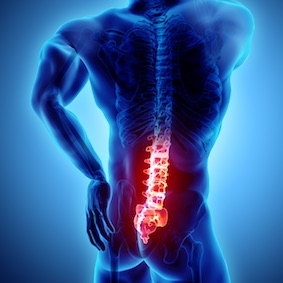What exactly is lower back pain?
Lower back pain can also be called lumbago or crick. The cause of lower back pain isn’t always clear. Strain and/or poor movement or poor posture can be possible explanations. In other cases, lower back pain can be a symptom of a slipped disc.
Common lower back pain complaints and symptoms
Lower back pain is felt in the lower back and can radiate down into your buttock or leg. It is primarily standing or sitting for a longer period that can be painful, but certain movements can cause discomfort too. It is hard to find the underlying cause of back pain. In most cases the pain has nothing to do with illnesses and it often resolves itself again without any long-term damage. Back pain can have a disruptive effect on your daily life but rest assured, it will usually get better over time.
Slipped Disc
If your back pain is radiating down into one or both legs, your back and/or buttock and beyond your knee (occasionally even into your foot) and grows worse during straining, coughing or sneezing, then these symptoms can be a sign of a slipped disc. A slipped disc occurs when an intervertebral disc compresses one of your spinal nerves. It is advisable to consult a GP or physiotherapist. In case of severe slipped disc, surgery could be necessary.
Back pain incidence and who does it affect?
Lower back pain is very common. About 50% to 90% of adults are likely to suffer from lower back pain at least once in their lives. Annually, this means about 20% of the (Dutch) population. Some people will only once experience back pain but for others it can become chronic.
Risk Factors
- A number of risk factors for back pain are:
- Physical inactivity
- Sitting or standing in the same position for long periods (repetitive movements at work)
- Sudden, explosive spurts of exercise
- Exposure to vibrations (by for instance vibrating vehicles or machines)
- Obesity
- Stress
Self-help for lower back pain
Normally, lower back pain gets better in a few days or weeks. The worst pain often disappears within one or two weeks. Even long-term or persistent back pain resolves within six to twelve weeks. The best advice is to maintain your normal routine as actively as you can, even though this can be difficult. Research shows that inactivity will hinder recovery. Keep moving but don’t overstrain. It is advisable to avoid physically intense housework, lifting heavy objects or maintaining the same position for a long time.
It is helpful to change position every so often or to go for a little walk. Don’t forget to take a break every now and again and to relax. This is vital because stress creates a tense posture which increases the risk of back pain. Bedrest is hardly ever necessary but sometimes it cannot be avoided. If this is the case, try to stay in bed no more than two days. Otherwise, your back will stiffen and your muscles might struggle to maintain their ability to move and exercise.
You can take painkillers if your pain is intense. However, it is best to only use them for a couple of days and, at any rate, no longer than twelve weeks. Please contact your GP or physiotherapist if the pain hasn’t diminished after a week or if it gets worse. If after three weeks your body still hasn’t regained its normal range of movement, if the pain radiates down to beyond your knee, you experience loss of strength or numbness in your leg or if you find you have trouble emptying your bladder, please don’t hesitate to contact your GP or physiotherapist.
Book an appointment
Physiotherapy treatment for lower back pain
If you find it difficult to stay active, you can consult a physiotherapist. Together you will find the right approach to pain relief. Together you can create a rehabilitation plan and discuss a time frame for taking up specific activities again. You will also be given exercises aimed at increasing muscle strength and improving your posture.
In case you need to undergo slipped disc surgery, a physiotherapist will be able to help you both before and after your operation. Before the operation, the focus will be on improving your physical condition in order to reduce your recovery time. After the surgery your physiotherapist can help with your rehabilitation. If you’re unsure about what you should and shouldn’t be doing, you can consult a physiotherapist. He will help you recovering from back pain and will see to it that you can take up your daily activities again. The treatment plan aims to teach you exactly how to manage your back pain when you experience discomfort. A physiotherapist will provide both advice and exercises.
Which other physical complaints does FysioCity treats?
Book an appointment
 NL
NL